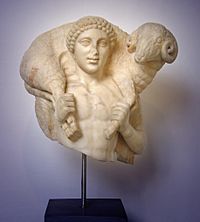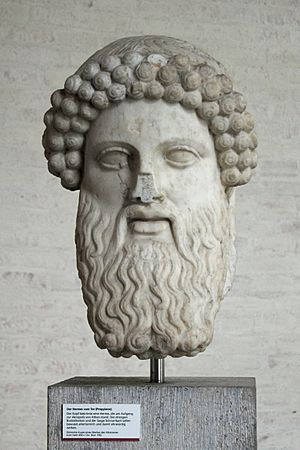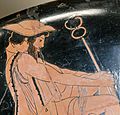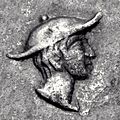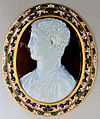Hermes facts for kids
Quick facts for kids Hermes |
|
|---|---|
| God of boundaries, roads and travelers, thieves, athletes, shepherds, commerce, speed, cunning, wit, and sleep. Psychopomp and divine messenger |
|
| Member of the Twelve Olympians | |

Archaic bearded Hermes from a herm, early 5th century BC.
|
|
| Abode | Mount Olympus |
| Planet | Mercury |
| Symbol | Talaria, caduceus, tortoise, lyre, rooster, Petasos (Winged helmet) |
| Day | Wednesday (hēméra Hermoû) |
| Personal information | |
| Children | Evander, Pan, Hermaphroditus, Abderus, Autolycus, Eudoros, Angelia, Myrtilus, Palaestra |
| Parents | Zeus and Maia Uranus and Hemera (Cicero and Hyginus) |
| Siblings | Aeacus, Angelos, Aphrodite, Apollo, Ares, Artemis, Athena, Dionysus, Eileithyia, Enyo, Eris, Ersa, Hebe, Helen of Troy, Hephaestus, Heracles, Minos, Pandia, Persephone, Perseus, Rhadamanthus, the Charites, the Horae, the Litae, the Muses, the Moirai |
| Equivalents | |
| Roman equivalent | Mercury |
| Norse equivalent | Odin |
| Etruscan equivalent | Turms |
| Egyptian equivalent | Thoth, Anubis |
Hermes is the messenger of the gods. He is the god of travellers and shepherds in Greek mythology. He is one of the Twelve Olympians, and is often shown with his caduceus.
His attributes and symbols include the herma, the rooster, the tortoise, satchel or pouch, talaria (winged sandals), and winged helmet or simple petasos, as well as the palm tree, goat, the number four, several kinds of fish, and incense.
In Roman mythology and religion many of Hermes' characteristics belong to Mercury, a name derived from the Latin merx, meaning "merchandise," and the origin of the words "merchant" and "commerce."
Hermes is the son of Zeus and Maia. He was born on Mount Cyllene. The story of his birth was told in the Homeric Hymn, which means Hymn to Hermes. It said that Maia was a nymph.
Hermes was very clever and on his first day invented the lyre, by using the shell of a tortoise. One of the myths about Hermes is that he once stole his brother's oxes, and burned them as a sacrifice.
Contents
Name and origin
Most scholars derive "Hermes" from Greek ἕρμα (herma), "stone heap." It is likely that Hermes is a pre-Hellenic god, though the exact origins of his worship, and its original nature, remain unclear. His cult was established in Greece in remote regions, likely making him originally a god of nature, farmers, and shepherds.
Iconography
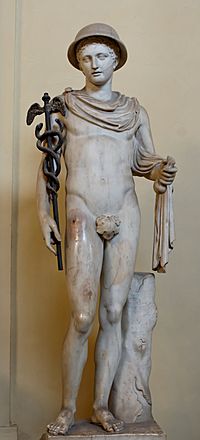
The image of Hermes evolved and varied along with Greek art and culture. In Archaic Greece he was usually depicted as a mature man, bearded, and dressed as a traveler, herald, or shepherd. In Classical and Hellenistic Greece, Hermes was usually depicted as a young, athletic man lacking a beard.
At all times, however, several of his characteristic objects are present as identification. Among these objects is a wide-brimmed hat, the petasos, widely used by rural people of antiquity to protect themselves from the sun, and that in later times was adorned with a pair of small wings; sometimes this hat is not present, and may have been replaced with wings rising from the hair.
Another object is the caduceus, a staff with two intertwined snakes, sometimes crowned with a pair of wings and a sphere. The caduceus, historically, appeared with Hermes, and is documented among the Babylonians from about 3500 BC. Two snakes coiled around a staff was also a symbol of the god Ningishzida, who, like Hermes, served as a mediator between humans and the divine (specifically, the goddess Ishtar or the supreme Ningirsu). In Greece, other gods have been depicted holding a caduceus, but it was mainly associated with Hermes. It was said to have the power to make people fall asleep or wake up, and also made peace between litigants, and is a visible sign of his authority, being used as a sceptre.
Hermes' sandals, called pédila by the Greeks and talaria by the Romans, were made of palm and myrtle branches but were described as beautiful, golden and immortal, made a sublime art, able to take the roads with the speed of wind. Originally, they had no wings, but late in the artistic representations, they are depicted. In certain images, the wings spring directly from the ankles. Hermes has also been depicted with a purse or a bag in his hands, wearing a robe or cloak, which had the power to confer invisibility.
Functions
Hermes was heavily associated with the earth and/or underworld. He was a god of boundaries (between life and death), a deity who helps guide souls of the deceased to the afterlife, and his image was commonly depicted on gravestones in classical Greece. Hermes is also worshiped as a messenger (since he can convey messages between the divine realms, the underworld, and the world of mortals).
Hermes was known as the patron god of flocks, herds, and shepherds. In Boeotia, Hermes was worshiped for having saved the town from a plague by carrying a ram or calf around the city walls. A yearly festival commemorated this event, during which a lamb would be carried around the city by "the most handsome boy" and then sacrificed, in order to purify and protect the city from disease, drought, and famine. Numerous depictions of Hermes as a shepherd god carrying a lamb on his shoulders (Hermes kriophoros) have been found throughout the Mediterranean world, and it is possible that the iconography of Hermes as "The Good Shepherd" had an influence on early Christianity, specifically in the description of Christ as "the Good Shepherd" in the Gospel of John.
Temples and sacred places
There are only three temples known to have been specifically dedicated to Hermes during the Classical Greek period, all of them in Arcadia. One of the oldest places of worship for Hermes was Mount Cyllene in Arcadia, where some myths say he was born. Tradition holds that his first temple was built by Lycaon. From there, the Hermes cult would have been taken to Athens, from which it radiated to the whole of Greece. In the Roman period, additional temples to Hermes (Mercury) were constructed across the Empire, including several in modern-day Tunisia.
As a patron of the gym and fighting, Hermes had statues in gyms and he was also worshiped in the sanctuary of the Twelve Gods in Olympia where Greeks celebrated the Olympic Games. His statue was held there on an altar dedicated to him and Apollo together.
Sacrifices to Hermes involved honey, cakes, pigs, goats, and lambs. In the city of Tanagra, it was believed that Hermes had been nursed under a wild strawberry tree, the remains of which were held there in the shrine of Hermes Promachus, and in the hills Phene ran three waterways that were sacred to him, because he was believed to have been bathed there at birth.
Children
- Tyche was a daughter with Aphrodite.
- Hermaphrodites was a son with Aphrodite.
Related pages
- Family tree of the Greek gods
- Mercury- Roman mythology version of Hermes.
Images for kids
-
Charon with punt pole standing in his boat, receiving Hermes psychopompos who leads a deceased woman. Thanatos Painter, ca. 430 BC
-
Hermes Fastening his Sandal, early Imperial Roman marble copy of a Lysippan bronze (Louvre Museum)
-
Hermes wearing a petasos. Coinage of Kapsa, Macedon, c. 400 BC.
-
Sardonyx cameo of a Ptolemaic prince as Hermes, Cabinet des médailles, Paris
See also
 In Spanish: Hermes para niños
In Spanish: Hermes para niños


